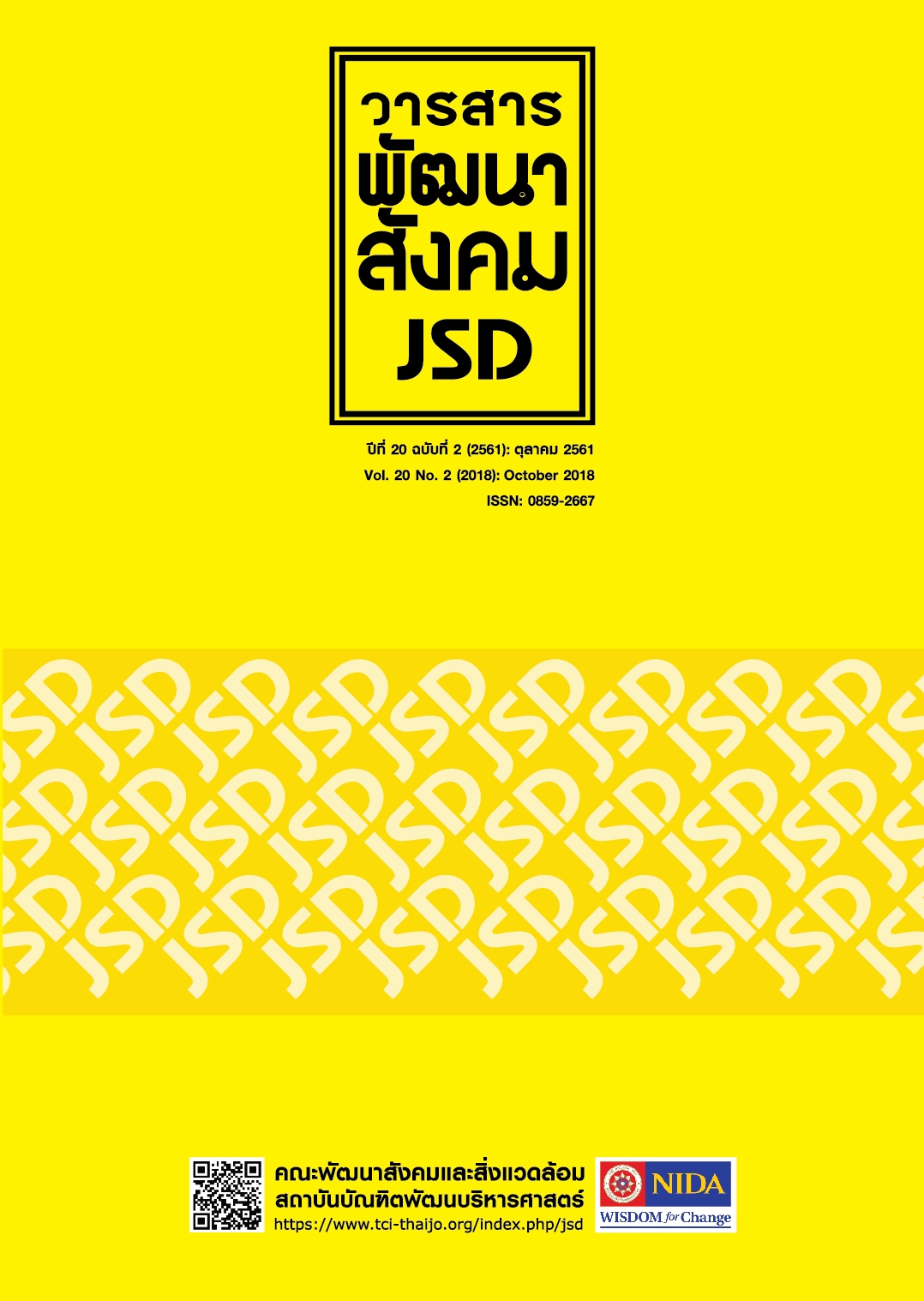Integration of Learning Management in ASEAN Studies and Borderland Studies : Synthesis of the Buffer Schools in Thailand*
Main Article Content
Abstract
This research paper is to assess the guidelines for learning management in ASEAN studies following the ASEAN curriculum sourcebook and local indigenous knowledge in cross border contexts for Buffer schools of Thailand. The studies were conducted in Buffer schools of Thailand involving 400 upper secondary students in Phanom Dong Rak Wittaya school, Suanphung Wittaya school, Wangnua Wittaya school and Betong Wiraratprasan school. The project is a mixed method research study which the result found that learning of border communities in Buffer schools were highly rated in indigenous languages, indigenous people and border tourist attractions; pathways of learning in ASEAN curriculum sourcebook was highly rated in the people and neighborhood (37.8%); and integration of ASEAN studies learning in border areas consists of knowledge; local history, outdoor learning resources in border communities to enhancing social and cross-cultural skills. This research was conducted with area-based curriculum concept as a synthesis of integration of learning management in ASEAN studies through four specific dimensions of knowledge comprises the geography of place; the history of place; the culture of place,; and community, people and place. Strengthening regional cohesion was based on neighborhoods within collective roots of ASEAN community.
Article Details
References
2. Alexander, R. J. (2008). Essays on Pedagogy (p. 141). London: Routledge.
3. Arphattanano, T. (2015). How Does the Current Wave of Globalization Affect Thailand’s Curriculum? Teaching Social Studies under AEC and ASEAN Community (pp. 17-32). Nakhon Pathom: Research Institute for Languages and Cultures of Asia, Mahidol University.
4. ASEAN Secretariat. (2012). ASEAN Curriculum Sourcebook (p .v ii). Washington: USAID (United States Agency for International Development).
5. Banks, J. A. (2013). An Introduction to Multicultural Education (pp. 4-17). Boston, MA: Pearson Education.
6. Barth, F. (1969). Introduction. In F. Barth (Ed.) Ethnic Groups and Boundaries: The Social Organization of Culture Difference (pp. 9-38). Prospect Heights, IL: Waveland Press.
7. Berdahl, D. (1999). Where the World Ended: Re-Unification and Identity in the German Borderland (p. 3). Berkeley/ Los Angeles: University of California Press.
8. Cannon, M. (2005). Cross-border Regionalism Co-operative Europeanisation or Competitive Globalisation? (pp. 3-22). World Society Focus Paper Series, A series edited by the World Society Foundation.
9. Donnan, H. & Wilson, T. M. (1999). Borders: Frontiers of Identity, Nation and State (pp.19-41). Oxford: Berg Press.
Evans, W. & Savage, J. (2015). Developing a Local Curriculum: Using Your Locality to Inspire Teaching and Learning (pp. 1-8). New York: Routledge.
10. Facer, K. (2010). Towards an Area-Based Curriculum: Insights and Directions from the Research (p. 3). London: RSA Action and Research Centre.
11. Jephcote, M. & Davies, B. (2007). School Subjects, Subject Communities and Curriculum Change: The Social Construction of Economics in the School Curriculum. Cambridge Journal of Education, 37(2), 207-227.
12. Kushner, S. (1993). One in a Million? The Individual at the Centre of Quality Control. In Elliott, J. (Ed.) Reconstructing Teacher Education: Teacher Development (pp. 39-50). London: Falmer Press.
13. Leach, E. R. (1954). Political System of Highland Burma: A Study of Kachin Social Structure. (pp. 108-125). London: The Ashlore Press.
14. Libora Oates-Indruchová, L. & Blaive M. (2014). Border Communities: Micro-studies on Everyday Life, Politics and Memory in European Societies from 1945 to the Present. Introduction to a Special Issue of Nationalities Papers, 42(1), p. 195.
15. NACCCE (National Advisory Committee on Creative and Cultural Education). (1999). All Our Futures: Creativity, Culture and Education (p. 47). London: DFEE.
16. Nathan Associates Inc. (2 0 1 2 ). Building the ASEAN Community in the Classroom. Retrieved from https://www.nathaninc.com/building-the-asean-community-inthe-classroom/
17. OBEC (Office of the Basic Education Commission). (2014A). Introducing ASEAN Curriculum Sourcebook, [in Thai] (p. 7). Bangkok: National Office of Buddhism.
18. ______________________________________________. (2014B). Handbook of ASEAN Studies (ASEAN Curriculum Sourcebook), [in Thai]. Bangkok: The Agricultural Cooperative Federation of Thailand, LTD.
19. QCA (Qualifications and Curriculum Authority). (2007). The New Secondary Curriculum: What has changed and why? (p. 5). London: QCA.
20. RSA (the Royal Society for the Encouragement of Arts, Manufactures and Commerce). (2012). Thinking about an Area Based Curriculum: A Guide for Practitioners (pp.5-6). London: RSA Action and Research Centre.
21. SEAMEO (Southeast Asian Ministers of Education Organization). (2010). Integrating Education for Sustainable Development into Secondary Education Social Studies Curriculum in Southeast Asia: A Toolkit for Educators, Curriculum Developers, and ESD Advocates (pp.8-13). Regional Center for Education Innovation and Technology. Quezon City: Philippines.
22. Smith, A. D. (1986). The Ethnic Origins of Nation (pp. 22-30). Oxford: Blackwell.
23. Sangkamanee, J. (2016). Methodology of Boundaries: Methodology at Boundaries, [in Thai]. Journal of Sociology and Anthropology, 35(1), 3-22.
24. Santasombat, Y. (2 0 1 4 ). Frontier and Border: Dimensions of Culture and History. In W. Panyakaeo (Ed.). Society in Transition: Transformation of Society, Academic Article on the Anniversary 50 Years of Faculty of Social Sciences, Chiangmai University, [in Thai] (pp. 181-217). Chiangmai: Vanida Printing.
25. Sungtong, A. (2014). Perspectives of Public School Administrators in the Three Southern Border Provinces on Multiculturalism and Multicultural Education, [in Thai]. Songklanakarin Journal of Social Sciences and Humanities, 20(3), 89-112.
26. Sunthonphesat, S. (2005). Anthropology and History, [in Thai] (pp. 68-78). Bangkok: Muang Boran Publishing House.
27. The Singapore Teachers’ Union. (2012). Enhancing Quality Education towards the Realisation of ASEAN Community 2015 (pp. 1-12). The 27th ASEAN Council of Teachers (ACT) Convention.
28. Venken, M. (2017). Borderland Studies Meets Child Studies: A European Encounter (pp.11-14). Frankfurt am Main: Peter Lang Edition.
29. Werther, S. (2014). An Unimaginable Community: The SS Idea of a Greater Germanic Reich and the German Minority in Denmark. In N. Götz (Ed.) . The Sea of Identities: A Century of Baltic and East European Experiences with Nationality, Class, and Gender (pp. 85-108). Huddinge: Södertörn University.


